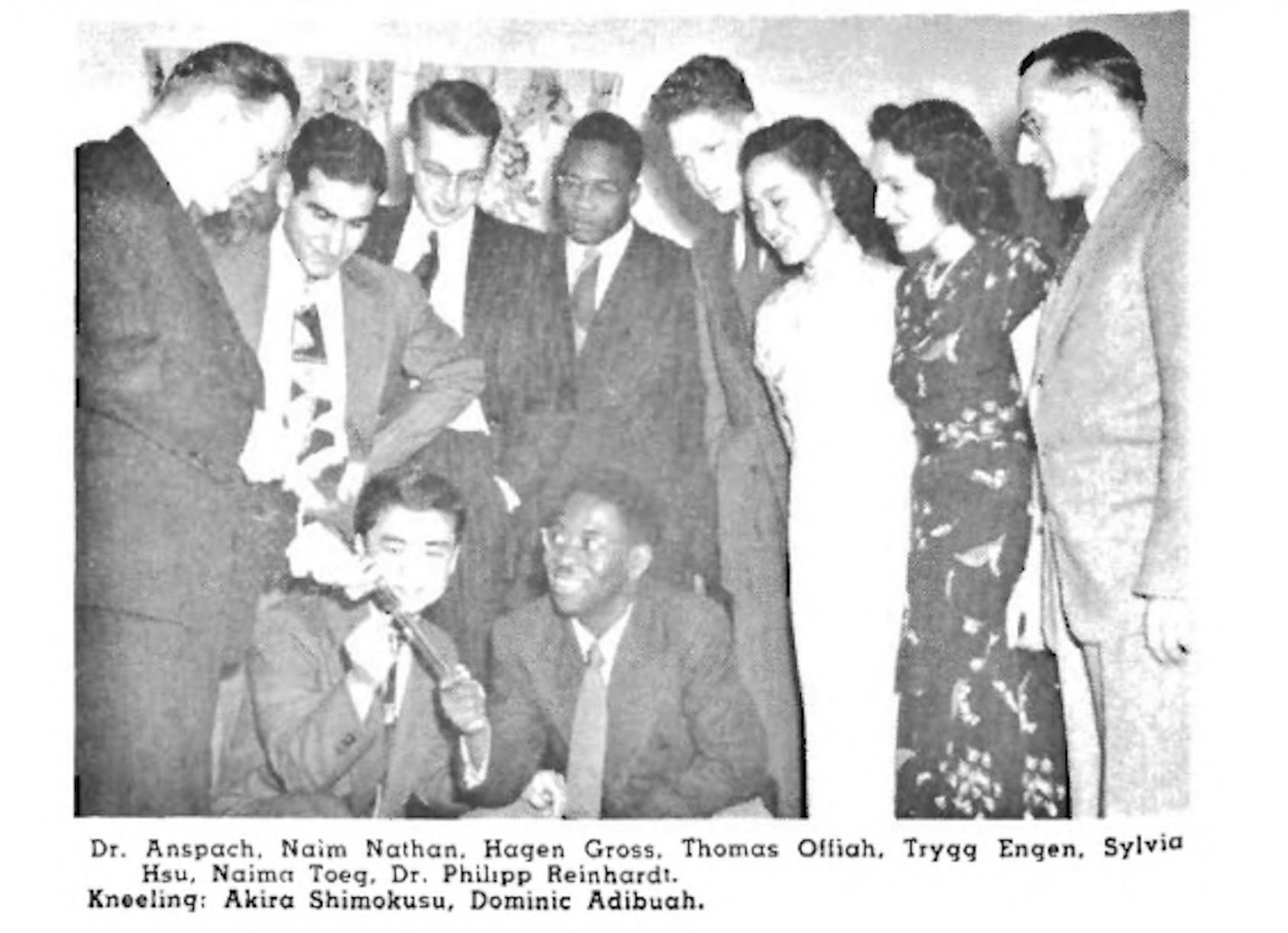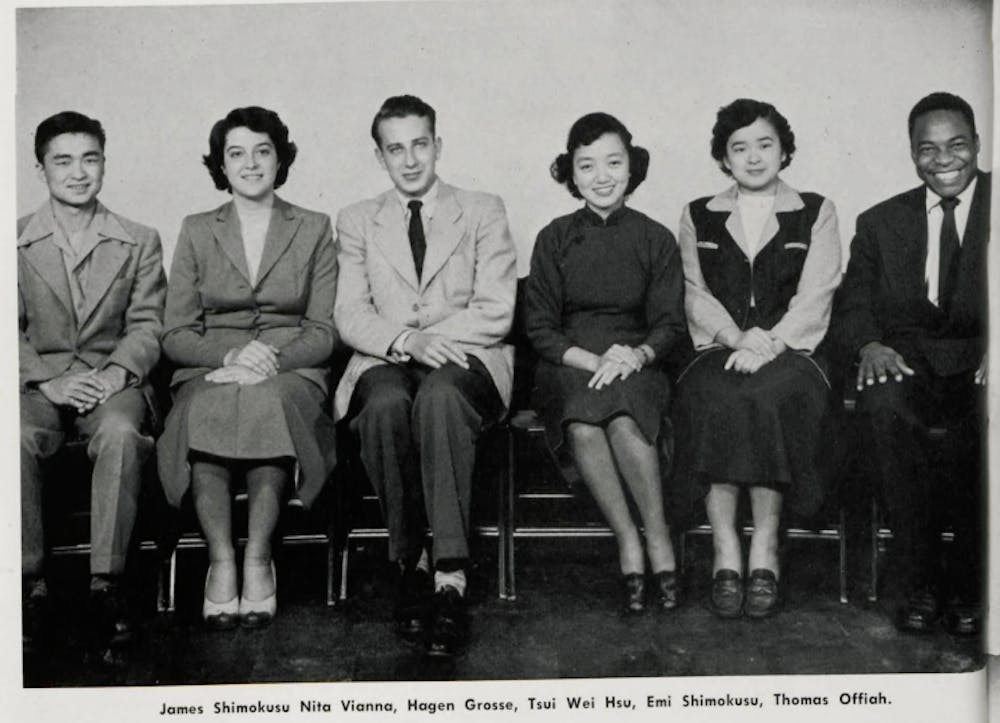MS NEWS: How has international diversity at CMU changed throughout years?
International student history, today and future
For Telugu version of this story, click here.
From 1930s to 2024, students from all over the world have found their second home at Central Michigan University.
“I believe that the whole reason CMU is focusing on finding experiences that get students from abroad and particularly help them understand other cultures, is based on this idea that the better we know each other, the less likely it is that we'll have misunderstandings that will lead to a nuclear holocaust,” Jay Martin, CMU museum director, said.
Making history today
This year, the influx of international students has made campus history.
Executive Director of the Office of International Affairs and Graduate Recruitment Ling Zhang said there are 2080 international students at CMU from 70 different countries.
In the last 10 years CMU international enrollment reached its highest in 2014 with 1,259 students; in 2015 with 1,344 students; and in 2023 with 1,726 students. It was at its lowest in 2019 with 676 students; 2020 with 466 students; and in 2021 with 536 students.
Majority of CMU’s international students are from Asian countries such as India, Bangladesh and Nepal. But the university has also started seeing an increase in the student population from Africa, Zhang said.
“(United States) universities are globally recognized for their high-quality education, research and diverse range of academic programs,” she said. “Many Asian students are attracted to the prestige associated with obtaining a degree from a US institution.”
Zhang said that during the COVID-19 pandemic students who planned to come to CMU couldn’t because of the visa and travel restrictions. She said that might have also contributed to international student numbers jumping in 2022 with 1,219 students, because “the gate was open.”
“We streamlined everything from application process to the services and to make it easier for international students to apply, to get to know about CMU,” Zhang said, explaining the numbers increase. “We have built some great partners and connections overseas. … We do recruitment trips, we meet (students), we do international recruitment fairs.”
“International students are the backbone of this university,” Carolina Hernandez Ruiz, a junior from Spain, said. “Considering that we are the ones who work in the most difficult jobs (like the dining halls.) Considering that we are the ones who paid most to be here.
“They also bring this culture and these cultural awareness … they bring a lot of diversity.”
However, Hernandez Ruiz said she didn’t see international students being involved in the leadership of the university. And she wants to see that change next year and help in doing so by running for the Student Government Association president position for fall 2024. If she wins, she will be the first SGA president who is an international student.
“For how long have (international) students have been coming here?” she said. “And this is the first year. Right before there has been a position to represent international students (international student service liaison), which again, international students represent a big part of campus.”
For how long have international students been coming here?

Courtesy of Clarke Historical Library, Central Michigan University.
To answer Hernandez Ruiz’s question, the earliest-known international students arrived at CMU before the World War II or by 1930s, Martin said.
“From far off Beyrut in Syria— from Harbin, seat of the SinoJapanese troubles in Manchuria— from the Philippines, from India, and five other countries will come the twenty University of Michigan students who will comprise the fourth annual delegation of foreign students to visit Central State Teachers College this afternoon,” Central State Life in “Foreign students from university will arrive here today” wrote on April 15, 1936.
Martin has been researching the history of international students at CMU for the honor’s class he teaches. Even though he estimated those dates based on what information that he researched, the research is not complete enough to answer to when exactly the first international student came to CMU, he said.
First students were coming to CMU in groups as part of tours organized by other Michigan universities in 1930s. They were coming for a short period of time to learn teaching techniques and observe the American educational system, Martin said.
After World War II, some CMU students who left college to serve in the American armed forces, came back home with “war brides,” women they met while overseas, who would then become students at CMU as well, Martin said.
The first war bride at CMU may be Maria Jencka, a Polish woman who married an American soldier, Martin said. Jencka was a pre-dental major and spoke five languages, according to Central Michigan Life story published on Nov. 20, 1946.
"Maria likes America and Central as a whole very much," the article read. "Her only regret was the fact she was unable to see her mother before she left because of Russian occupation. She could go to her but to be able to come out of the occupation zone was very doubtful."
Martin also said soldiers would bring their friends from other countries. For example, there was an American soldier who invited his German friend, who then became a student at CMU.
For the first years that CMU had international students, the university would refer to them as “foreign students,” according to a Centralight article published in 1949. When Hawaii became a state in 1959, students from the island migrating to CMU were still referred to as foreigners.
By 1960s, the majority of international students were from India and Pakistan, Martin said. That could have happened because India and Pakistan gained their independence in 1947.
“In the post-World War II era, achieving independence had become the goal and an essential part of the identity of peoples around the world,” Martin said.
After the Cold War, cultural exchange programs became more prevalent as well, first among high school students, as “an attempt to combat the idea that misunderstandings would lead us to an apocalypse,” Martin said.
A person who has brought and took care of international students at CMU was Gerald Poor.
“Under the able advisorship of Dr. Gerald L. Poor, the Foreign Students Association proves itself to be a very worthwhile organization,” Chippewa article said.
Martin said Poor didn’t only run the Foreign Student Association club, but wrote several stories introducing foreign students.
“Gerald L. Poor became the catalyst for really focusing on bringing international students here, and you can read … in this article about the kinds of things students were engaged in,” he said.
The article Martin referenced was titled “Introducing the students who came to Central from other lands." Besides Patten and Shimokusu, who were from Hawaii, Poor also introduced:
· Delta Jackson from Virgin Islands was a citizen of the U.S., but she was still a part of the Foreign Student Association. Jackson worked in elementary education and went back to the islands as a teacher. What she didn’t like about CMU was cold wind.
· Naim Nathan from Iraq studied pre-architectural engineering. He experienced the challenge of going from a life in a big city – Baghdad – to a small town like Mount Pleasant.
· Naima Toeg from Iraq could not find time to do all the things she wanted but had “wonderful” people on her way.
· Thomas Offiah from Nigeria studied English for four years and planned to return to Nigeria to teach. His father was a Tribal Chieftain.
· Dominic Adibuah from Nigeria was Offiah’s classmate at high school. He missed soccer.
· Trygg Engen from Norway was a brother of 1948 alumna Eli Engen. Trygg was interested in winter sports and wished Mount Pleasant would have been colder.
· Sylbia Hsu from China was majoring in Political Science and Sociology. She had been welcomed on campus and did not think of herself as a “foreign student.”
· Dr. Philipp Reinhardt from Germany was forced to join the army and spent three months in a British camp as a prisoner of war. After the war, he was selected with other German educators to train in the U.S.
· Hagen Gross from Germany was on the same plane with Reinhardt, but they didn’t realize they were going to the same place. He spoke English “flawlessly” and even had an American accent.
· Elvia Escobar from Guatemala studied elementary education. Escobar found CMU overwhelming with 2400 students at that time. She carried a dictionary with her because of troubles with English.
“Each year, Central has a group of students who come from outside the continental limits of the United States,” Poor wrote. “They go about their duties and their pleasures as do other students. They are accepted into the life of the campus, make contributions to it in many ways, and receive help from it.
“You’ll find their room addresses in Barnard, Ronan, Sloan (and) Keeler. You’ll find them having coffee in the Annex, or chemistry in Grawn. They belong.”
Martin said the idea of getting to know people around the world is important.
“International students are frankly one of the best ways to do that,” Martin said.
“The people who came back from those experiences (after the World War II) and (descendants of) their children like me, believe that it was important that we leave the world a better place than when we entered the war,” Martin said. There was a sense of, if we can work together and get to know each other better than it's less likely that these kinds of things that catastrophe will occur.”
What is next?
The importance of international students is valued on the campus in 2024 still, Zhang said. She said she was an international student in the U.S. herself, and that’s why assisting them gives her a sense of purpose and fulfillment.
"I understand the challenges and experiences that come with studying in a foreign country,” Zhang said. “My own journey involved overcoming language barriers, adjusting to a new culture and navigating unfamiliar academic systems. This empathy allows me to relate to the struggles of international students and provide them with valuable support and guidance.”
For future recruitment, Zhang follows the multi-level recruitment plan that includes visiting partners in other countries, doing virtual connections with students if she can’t travel to them, attracting students through the good experiences they see their friends having at CMU and meeting international high school counselors.
"We are here to support our international students, and we want to make sure they know during their CMU journey, they are not alone," Zhang said.




